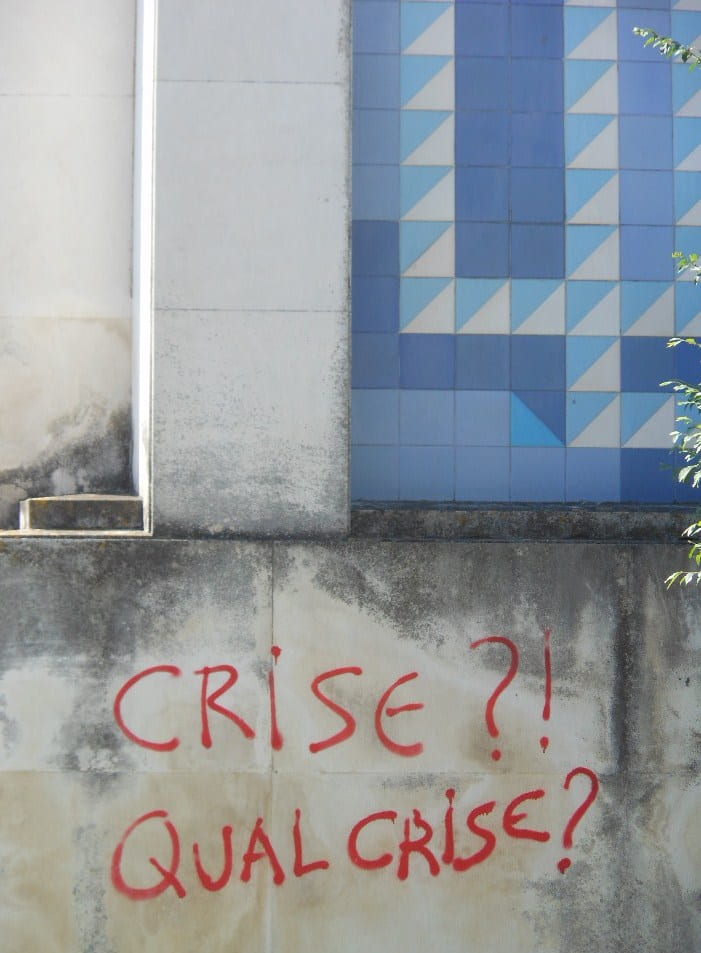By guest contributor Alex Langstaff
“The concept ‘crisis’ has indeed become a motto of modern politics, and for a long time it has been part of normality in any segment of social life,” argued Giorgio Agamben in a 2013 interview with the Frankfurter Allgemeine Zeitung. He further explained:
“The very word expresses two semantic roots: the medical one, referring to the course of an illness, and the theological one of the Last Judgement. ‘Crisis’ in ancient medicine meant a judgement, when the doctor noted at the decisive moment whether the sick person would survive or die. The present understanding of crisis, on the other hand, refers to an enduring state. So this uncertainty is extended into the future, indefinitely” and “an endless process of decision never concludes.”
A leading Italian philosopher well-known for his theory of the state of exception, Agamben borrowed this genealogy of crisis almost exactly from Reinhart Koselleck’s entry in the Geschichtliche Grundbegriffe (in Volume 3, 1982), published in the Journal of the History of Ideas in 2006 with the excellent translation of Michaela Richter. It is perhaps one of the most influential single conceptual histories, compounding into so many layers of reference that it has taken on the appearance of a historical document in little under forty years. Koselleck called crisis the “structural signature of modernity,” scrawled in Schiller’s hand through his dictum of ‘World History is the Last Judgement.’ (372-95) Its “metaphorical flexibility,” and the dual valence of diagnostic and judgement, helped crisis to become a contemporary buzzword and an ambivalent analytical tool—sometimes system-immanent, sometimes system-exploding.

Sovereign debt, climate change, refugeedom, liberalism: we indeed seem to live in times of crisis. There has been talk of the “crisis in crisis” as well as the need for an “anti-crisis” from scholars weary of the concept’s shaky foundations and its apparent tendency in conjunctures such as the 2008 financial meltdown to foreclose possibilities, rather than to open them. One recent observer has even suggested that a “crisis paradigm” runs amok in political and social theory, harboring an epistemic blind-spot to the ways the determination of crises is used to advance normative claims.
This interdisciplinary conversation about what crisis means, where it came from, and how we deploy it has a longer history. In 1976, the prominent French sociologist Edgar Morin had already decided that the concept of crisis was becoming so overused and emptied of meaning that the concept’s own experience of crisis would eventually resurrect it. “The crisis of the concept of crisis is the beginning of the theory of crisis,” he enthused. (162-3) Yet, these were the first steps to a crisologie that never came. We can self-reflexively recognize crisis as a vague category of analysis, a ramifying narrative structure, or a moving target of presentism. But even explanations of presentism, such as François Hartog’s, routinely fall back onto diagnosing…a “crisis of time.” Crisis and critique: a recursive partnership.

But what happens to the conceptual histories of modernity when modernity becomes a tradition? Here, Christian Geulen has asked a pertinent question. For many, the Geschichtliche Grundbegriffe seems outdated, a vestige of postwar efforts to trace the pathogenesis of Europe’s destruction to the Enlightenment. Yet, if Alf Lüdtke has shown himself skeptical of the work’s utility as a eurocentric anachronism, Geulen appears confident it can be renovated through a radical overhauling of its analytical tools and geolinguistic boundaries. Willibald Steinmetz shares Geulen’s optimism, arguing that Koselleck’s notions of conceptual democratization and temporalization have been accomplished, while politicization and ideologization (the increasing abstraction of concepts into -isms) continue to repeat throughout the twentieth and twenty-first centuries.
Asking “What Is Dead and What Is Alive in Conceptual History?,” Jan-Werner Müller has equally found hope in the idea of a “critical conceptual history of the present.” Koselleck did consider crisis “as an everyday experience,” but a critical history would explore song, games, and the other discursive mediums of non-elite actors, engaging in a hybrid histoire de mentalités that is closer to Rolf Reichardt’s efforts in the mid-1980s Handbuch politisch-sozialer Grundbegriffe in Frankreich 1680-1820. Does jettisoning the Sattelzeit also mean rethinking the “signature of modernity” then? Curiously, Koselleck’s text on crisis runs through the cutting-edge interdisciplinary scholarship that engages the term as a common thread. Perhaps Begriffsgeschichte 1.0 might be more alive and well in other scholarly fields than we have recognized.

Koselleck understood the vital function of Begriffsgeschichte to be the precision of political and social language. In his view, revealing “the plenitude or poverty” of meaning in concepts would empower his readers to “establish a degree of semantic control over the use of (social and political) language today.” This modus vivendi helps us understand Koselleck’s presentation of crisis. “The concept of crisis, which once had the power to pose unavoidable, harsh and non-negotiable alternatives,” he writes in the introduction to the Geschichtliche Grundbegriffe, “has been transformed to fit the uncertainties of whatever might be favored at a given moment.” But Koselleck adds a twist:
“Such a tendency towards imprecision and vagueness, however, may itself be viewed as the symptom of a historical crisis that cannot as yet be fully gauged. This makes it all the more important for scholars to weigh the concept carefully before adopting it in their own terminology.”
Another crisis of crisis?
Two decades into the brave new twenty-first century, the owl of Minerva has not yet spread its wings and the deeper malaise Koselleck mysteriously alluded to remains intact. But focusing on crisis in his work—a conceptual theme, I argue, that ties much of it together—suggests several new possible directions for Begriffsgeschichte. For one, the relationship of hermeneutics to Koselleck’s Begriffsgeschichte still awaits exploration. Arriving from historical sociology, Isaac Reid has suggested a “full-blown crisis hermeneutics” (275) to explore how the “backcloth of action” is rewoven after it is torn. Second, conceptual histories have yet to engage space. The focus on Koselleck has understandably been temporal, and Geulen suggests considering spatialization as merely a process of recent conceptual evolution. But how might crisis spaces have undergirded temporalization? Agamben’s notion of the state of exception has proved so attractive to scholars because it captures both dimensions, such as in extraterritoriality. Finally, though Begriffsgeschichte has yet to transcend its nation-state and European containers, Koselleck sensed an opening for an outright planetary scale. His attention to the acceleration of eschatological time positioned nuclear planetary annihilation as a “final decision,” a modern katechon whose possible dissolution lay in “looking out for stabilizers which can be derived from the long duration of prior human history.” (246) Whether or not this was an opening into deep history, or merely the longue durée of theological temporality, Koselleck ultimately proposed “an ecology of the present” (29-33) in his later reflections on the “ecological crisis” enfolding the planet—and Begriffsgeschichte with it.
Alex Langstaff is a PhD candidate in modern European history at NYU.
[mc4wp_form id=”12317″]



July 18, 2019 at 7:19 am
What an excellent, sensitive piece, Alex! I would only add that many wonderful French philosophers (following in the wake of François Hartog’s work on “régimes d’historicité”; for instance, cf. https://www.lemonde.fr/tant-de-temps/article/2016/09/30/francois-hartog-on-a-acquis-la-conviction-que-nos-enfants-et-petits-enfants-vivront-moins-bien-que-nous_5005851_4598196.html) have come to similar conclusions, including Christophe Bouton (http://www.editionsbdl.com/fr/books/le-temps-de-lurgence/70/) and Myriam Revault d’Allonnes (http://www.seuil.com/ouvrage/la-crise-sans-fin-myriam-revault-d-allonnes/9782021054040).
As for Koselleck and hermeneutics, readers may be interested in an exchange that he had with his friend and colleague Hans-Georg Gadamer (1986: https://www.winter-verlag.de/de/detail/978-3-8253-3932-6/Koselleck_Gadamer_Hermeneutik_1987_1_POD_/), reprinted as “Historik und Hermeneutik” and “Historik und Sprache. Eine Antwort von Hans-Georg Gadamer” in “Zeitschichten: Studien zur Historik, Suhrkamp, 2000, p. 97-130 (https://www.suhrkamp.de/buecher/zeitschichten-reinhart_koselleck_29256.html). Also see Koselleck’s “Er konnte sich verschenken. Gedenkrede auf Hans-Georg Gadamer” in Vom Sinn und Unsinn der Geschichte, Suhrkamp, 2013, p. 349-364 (https://www.suhrkamp.de/buecher/vom_sinn_und_unsinn_der_geschichte-reinhart_koselleck_29690.html).